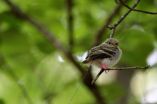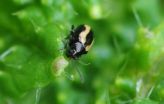(Press-News.org) Researchers at the Max F. Perutz Laboratories (MFPL) of the University of Vienna and the Medical University of Vienna made a breakthrough for the Platynereis model system, as they describe the first method for generating specific and inheritable mutations in the species. The method, in combination with other tools, now places this marine bristle worm in an excellent position to advance research at the frontiers of neurobiology, chronobiology, evolutionary developmental biology and marine biology. The study and a review on Platynereis dumerilii genetic methods were chosen by the renowned journal Genetics as one of the May 2014 Highlights and also got the cover image.
Many fascinating biological phenomena, of which we currently have little to no molecular understanding, can be observed in the tiny marine bristle worm Platynereis dumerilii. It displays a slow rate of evolution, which permits analyses of ancestral genes and cell types, possesses a vertebrate-type hormonal system, as well as the ability to regenerate large pieces of its body. Furthermore, its reproductive timing is controlled by multiple timers – a feature likely to be common to many other organisms. These characteristics make it an ideal model for evolutionary studies as well as for chronobiology, amongst other research fields. However, dissecting Platynereis gene function in vivo had remained challenging due to a lack of available tools.
TALENs as a new tool to engineer targeted modifications in Platynereis genes
To address this need, scientists from the Max F. Perutz Laboratories (MFPL) and the Research Platform "Marine Rhythms of Life" of the University of Vienna and supported by the VIPS (Vienna International Postdoctoral program) have now established customized transcriptional activator-like effector nucleases (TALENs) as a tool to engineer targeted modifications in Platynereis genes. These tailored enzymes bind specific DNA sequences and "cut" the genome at these locations. The repair mechanisms of the cell promptly repair the damage, however small errors in the form of insertions and deletions can be introduced during the repair process. The result is the generation of small mutations that render the protein product of the gene non-functional – allowing the generation of the first-ever Platynereis mutants.
Future directions
The researchers found out that the induced mutations are heritable, demonstrating that TALENs can be used for generating mutant lines in this bristle worm. "This new tool opens the door for detailed in vivo functional analyses in Platynereis and can also facilitate further technical developments. For example, we hope to use TALENs to insert fluorescent reporter genes into the genome. In this way we can study how gene expression is regulated across the entire lifecycle", explains first author Stephanie Bannister, VIPS Postdoc in Florian Raible's group at the Department of Microbiology, Immunobiology and Genetics at the University of Vienna. She spearheaded the establishment of the technique. "In addition, we have provided a streamlined workflow that can serve as a template for the establishment of TALEN technology in other non-conventional and emerging model organisms", Stephanie Bannister adds.
INFORMATION:
Original publications in Genetics:
Stephanie Bannister, Olga Antonova, Alessandra Polo, Claudia Lohs, Natalia Hallay, Agne Valinciute, Florian Raible, Kristin Tessmar-Raible: TALENs mediate efficient and heritable mutation of endogenous genes in the marine annelid Platynereis dumerilii. In: Genetics (March 2014). DOI: http://dx.doi.org/10.1534/genetics.113.161091
Juliane Zantke, Stephanie Bannister, Vinoth Babu Veedin Rajan, Florian Raible, Kristin Tessmar-Raible: Genetic and genomic tools for the marine annelid Platynereis dumerilii. In: Genetics (May 2014) DOI: http://dx.doi.org/10.1534/genetics.112.148254
The Max F. Perutz Laboratories (MFPL) are a center established by the University of Vienna and the Medical University of Vienna to provide an environment for excellent, internationally recognized research and education in the field of Molecular Biology. Currently, the MFPL host around 60 independent research groups, involving more than 500 people from 40 nations.
Breakthrough made at Max F. Perutz Laboratories
Platynereis functional advancements as one of Genetics' May highlights
2014-05-08
ELSE PRESS RELEASES FROM THIS DATE:
Fungus may help stop invasive spread of tree-of-heaven
2014-05-08
A naturally occurring fungus might help curb the spread of an invasive tree species that is threatening forests in most of the United States, according to researchers.
Researchers tested the fungus -- Verticillium nonalfalfae -- by injecting it into tree-of-heaven, or Ailanthus, plots, according to Matthew Kasson, who recently received his doctorate in plant pathology and environmental microbiology from Penn State. The treatment completely eradicated the tree-of-heaven plants in those forests.
"It appears that this treatment is effective in Pennsylvania and could ...
New paper provides important insights into carcinoma-associated fibroblasts
2014-05-08
A new paper by a team of researchers led by Zachary T. Schafer, Coleman Assistant Professor of Cancer Biology in the Department of Biological Sciences at the University of Notre Dame, offers important new insights into the role carcinoma-associated fibroblasts (CAFs) play in tumor biology. A number of recent studies have revealed CAFs to be a major contributor to tumor progression through a variety of mechanisms. Despite this information, the precise role CAFs play in augmenting the growth of tumors is still poorly understood.
In their new paper, Schafer and his fellow ...
'Teenage' songbirds experience high mortality due to many causes, MU study finds
2014-05-08
Nearly one-third of songbird species across North America are experiencing long-term declines. Scientists have spent years researching potential causes for these population declines, focusing on the birds when they have just hatched as well as when they are adults. Now, researchers from the University of Missouri and the U.S. Department of Agriculture have found that songbirds are vulnerable to environmental dangers particularly when they are juveniles, shortly after they have left their parents' nests. Frank Thompson, a scientist with the USDA Forest Service and an associate ...
Hepatitis C virus: How viral proteins interact in human cells
2014-05-08
Viruses use human cells in order to multiply and spread. This process involves interactions with cellular host factors as well as virus-virus interactions. For example interactions among viral proteins are essential for the assembly of newly produced infectious virions.
Interaction network explains viral mechanisms and opens up possibilities for new treatments
Hepatitis C virus (HCV) forms a precursor protein, which is processed into ten viral proteins. Scientists at the Institute of Virology at the Helmholtz Zentrum have now discovered how these proteins interact with ...
Promising role for interleukin-10 in scarless wound healing
2014-05-08
New Rochelle, NY, May 8, 2014—The powerful anti-inflammatory compound interleukin-10 (IL-10) plays a crucial role in regenerative, scarless healing of fetal skin. Studies of IL-10 in postnatal skin wounds have demonstrated its promise as an anti-scarring therapeutic agent, as described in a Critical Review article published in Advances in Wound Care, a monthly peer-reviewed journal from Mary Ann Liebert, Inc., publishers and an Official Journal of the Wound Healing Society. The article is available free on the Advances in Wound Care website.
In "Regenerative Wound Healing: ...
Detecting trace amounts of explosives with light
2014-05-08
University of Adelaide research may help in the fight against terrorism with the creation of a sensor that can detect tiny quantities of explosives with the use of light and special glass fibres.
Published in the journal Sensors and Actuators B: Chemical, the researchers describe a novel optical fibre sensor which can detect explosives in concentrations as low as 6.3 ppm (parts per million). It requires an analysis time of only a few minutes.
"Traditionally explosives detection has involved looking for metals that encase them such as in land mines," says project leader ...
'Parent' cells reset the cell division clock
2014-05-08
Melbourne researchers have overturned a 40-year-old theory on when and how cells divide, showing that 'parent' cells program a cell division time for their offspring that is different from their own.
Scientists from the Walter and Eliza Hall Institute have shown that both phases of the cell cycle contribute to the overall change in division time rather than one staying fixed in duration as previously thought. They have developed these findings into a new model that helps scientists predict how a population of cells has divided.
Their research could impact our understanding ...
Low-carbohydrate diet reduced inflammation
2014-05-08
A low-carbohydrate diet, but not a low-fat diet, reduces inflammation in patients with type 2 diabetes, according to research at Linköping University in Sweden.
It is known that patients with type 2 diabetes have higher levels of inflammation than those who do not have the disease, and it is believed that this may contribute to a higher risk of cardiovascular disease and other complications. In a clinical trial at Linköping University a low-carbohydrate diet was compared with a traditional low-fat diet in 61 patients with type 2 diabetes. Only patients in the low-carbohydrate ...
Public perceive alcohol adverts breach regulatory code, research finds
2014-05-08
A majority of the UK general public perceive alcohol adverts to breach the Advertising Standards Authority's Broadcast Committee of Advertising Practice (BCAP) Code suggesting that the current regulatory system for UK television is inadequate, research from The University of Manchester shows.
Researchers surveyed 373 adults, aged 18-74 years, showing them one of seven adverts that had been broadcast in the previous month on leading commercial television channels.
Overall 75 per cent of the participants rated the adverts as breaching at least one rule from the BCAP Code ...
Beetles that taste like mustard
2014-05-08
Almost all herbivorous insects are specialized to feed on specific host plants and have adapted to their chemical defenses. Flea beetles are important pests of cabbage and other cruciferous plants, such as mustard, horseradish and rapeseed. These plants use a sophisticated defense system, known as the mustard oil bomb, to get rid of their enemies : If plant tissues are wounded, glucosinolates and an enzyme known as myrosinase come into contact, and, as a result, toxic metabolites are formed which deter most insects. This defensive mechanism, however, has no negative effect ...
LAST 30 PRESS RELEASES:
Routine scans could detect early prostate radiotherapy changes
Fairness in AI: Study shows central role of human decision-making
Pandemic ‘beneath the surface’ has been quietly wiping out sea urchins around the world
Tea linked to stronger bones in older women, while coffee may pose risks
School feeding programs lead to modest but meaningful results
Researchers develop AI Tool to identify undiagnosed Alzheimer's cases while reducing disparities
Seaweed based carbon catalyst offers metal free solution for removing antibiotics from water
Simple organic additive supercharges UV treatment of “forever chemical” PFOA
£13m NHS bill for ‘mismanagement’ of menstrual bleeds
The Lancet Psychiatry: Slow tapering plus therapy most effective strategy for stopping antidepressants, finds major meta-analysis
Body image issues in adolescence linked to depression in adulthood
Child sexual exploitation and abuse online surges amid rapid tech change; new tool for preventing abuse unveiled for path forward
Dragon-slaying saints performed green-fingered medieval miracles, new study reveals
New research identifies shared genetic factors between addiction and educational attainment
Epilepsy can lead to earlier deaths in people with intellectual disabilities, study shows
Global study suggests the underlying problems of ECT patients are often ignored
Mapping ‘dark’ regions of the genome illuminates how cells respond to their environment
ECOG-ACRIN and Caris Life Sciences unveil first findings from a multi-year collaboration to advance AI-powered multimodal tools for breast cancer recurrence risk stratification
Satellite data helps UNM researchers map massive rupture of 2025 Myanmar earthquake
Twisting Spins: Florida State University researchers explore chemical boundaries to create new magnetic material
Mayo Clinic researchers find new hope for toughest myeloma through off-the-shelf immunotherapy
Cell-free DNA Could Detect Adverse Events from Immunotherapy
American College of Cardiology announces Fuster Prevention Forum
AAN issues new guideline for the management of functional seizures
Could GLP-1 drugs affect risk of epilepsy for people with diabetes?
New circoviruses discovered in pilot whales and orcas from the North Atlantic
Study finds increase in risk of binge drinking among 12th graders who use 2 or more cannabis products
New paper-based technology could transform cancer drug testing
Opioids: clarifying the concept of safe supply to save lives
New species of tiny pumpkin toadlet discovered in Brazil highlights need for conservation in the mountain forests of Serra do Quiriri
[Press-News.org] Breakthrough made at Max F. Perutz LaboratoriesPlatynereis functional advancements as one of Genetics' May highlights





